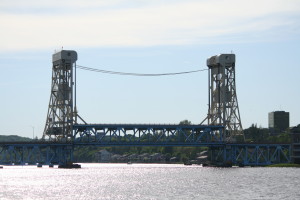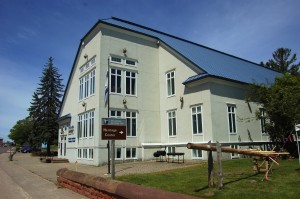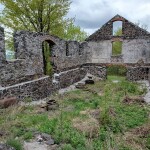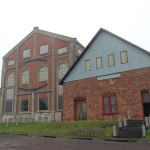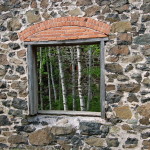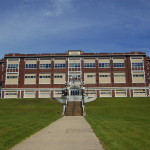
26 Things to See and Do on the Copper Country Trail National Byway
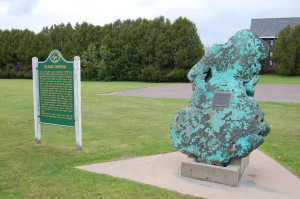
Michigan’s Keweenaw Peninsula was home to the nation’s first copper boom, and for thirty years in the 1800s it produced three-quarters of the nation’s copper. The history of this area is closely tied to the early success of the mining industry, as well as all of the immigrants who came to the area for jobs and a chance at a better life. The Copper Country Trail National Byway takes Keweenaw visitors on a journey through this area, highlighting well-preserved historic structures with ties to the past while also showcasing the area’s rich abundance of outdoor recreation opportunities. This 47 mile route begins at the Portage Lake Lift Bridge and ends in Copper Harbor, the northernmost mainland point in Michigan. Short spur routes lead to McLain State Park, Lake Linden, Gay-Lac LaBelle, Eagle River, and Eagle Harbor. In this post we will showcase 26 things to see and do on this scenic drive that is perfect for anything from a day trip to a weeklong vacation.
Portage Lake Lift Bridge – The journey into Copper Country begins at the Portage Lake Lift Bridge, which connects the cities of Houghton and Hancock across the Portage Canal. This 500 foot bridge was built in 1959 to replace an aging swing bridge. The bridge’s middle section can be raised to provide a clearance of 100 feet for vessels passing underneath. Both US-41 and M-26 are routed across this bridge, and after crossing they split, with M-26 heading east and US-41 (Copper Country Trail) heading to Copper Harbor. There are many great viewpoints for the bridge in both Houghton and Hancock.
Finlandia University – Hancock is home to Finlandia University, the only private university in the Upper Peninsula. It was founded in the late 1800s as Suomi College, with the goal of preserving the Finnish heritage of many of the immigrants who had traveled to this region for jobs in the mining industry. The Finnish American Heritage Center (part of the Keweenaw National Historic Park) is located on Quincy St. and is home to archives, artifacts, genealogical records, and more. Directions, hours, and events schedule at http://www.finlandia.edu/fahc/.
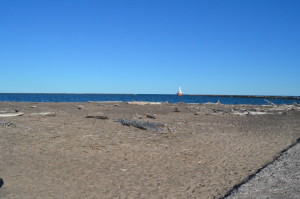
M-203 Spur Route – This 18 mile side route runs from Hancock to Calumet and provides access to McLain State Park. This Michigan state park is home to the Keweenaw Waterway Upper Entrance Light, a campground, Lake Superior beach, hiking and cross country skiing trails, as well as boating and fishing opportunities. A Michigan state recreation passport is required for entry.
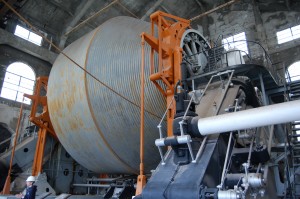
Quincy Mine – One of the most-visited sites in the entire Keweenaw Peninsula is the Quincy Mine, where copper was mined from 1848 to 1945. Quincy was nicknamed “Old Reliable” as it paid dividends to shareholders for nearly sixty years. Today you can visit the mine through a tour of the surface buildings and/or a trip into the mine itself by way of a cog-rail tram and wagon ride underground. The mine is also home to the Nordberg Steam Hoist, the world’s largest steam hoist. Find out more about hours of operation and tour prices at http://quincymine.com/.
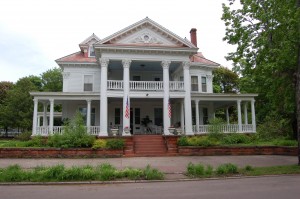
Laurium Mansion – The Thomas H. Hoatson house is the largest mansion in the western Upper Peninsula and is known for its detail-oriented construction and beauty. It now operates as a bed and breakfast and is open for tours. Built in 1908 it “has 10 guestrooms with private baths in its 13,000 square feet on four floors. A parlor, library, den, dining room, and third floor ballroom are all open for guests to use and enjoy.” Find out more at http://www.laurium.info/.
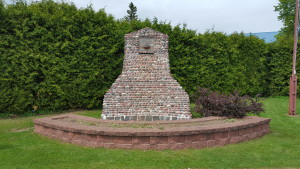
George Gipp Memorial Park – Legendary Notre Dame football player George Gipp was born in Laurium in 1895. Gipp enjoyed a four year Varsity career at Notre Dame. He played halfback, quarterback, and punter for the Fighting Irish. He led the team in rushing and passing his last three seasons (1918, 1919, 1920). To this day, Gipp still holds several Notre Dame records. This includes average yards per rush in a season (8.1), career average yards per play of offense (9.37), and average yards per game in a career (128.4). He died an early death at the age of 25 after catching an infection, and it was on his deathbed that his famous line “win one for the Gipper” was said to coach Knute Rockne. This park in Laurium honors his memory and features the names of all George Gipp award winners (best male athlete at Laurium High School).
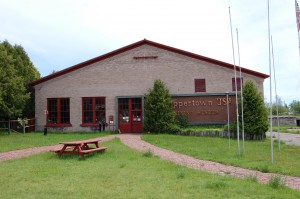
Coppertown USA Mining Museum – This museum focuses on the history of the Calumet & Hecla mining company, which was the largest operation in the Keweenaw. Learn about more than just mining, as exhibits tell of the things C & H did to improve miners’ lives – hospitals, schools, recreation and more. Head over to http://www.uppermichigan.com/coppertown/main.html for more information. Many of the surviving C &H buildings can be found within a few blocks of this museum.
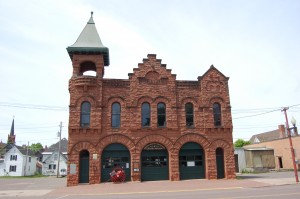
Upper Peninsula Firefighters Memorial Museum – An 1898 fire station made of Lake Superior sandstone in Calumet is a monument to the detailed construction and quality craftsmanship of the mining era. It also house a museum dedicated to the brave firefighters of the Copper Country, with almost 100 years of historical photos and artifacts. Located at 327 Sixth St. in downtown Calumet.
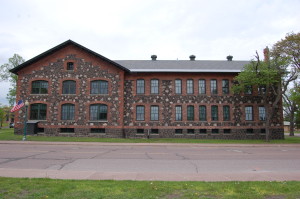
Keweenaw NHP Headquarters and Visitor Center – It’s worth stopping by the park’s administrative headquarters to see the stunning stone work on the building that once housed the C & H Mine Offices – it’s one of the most beautiful and detailed buildings that remains from the mining boom. The Calumet Visitor Center “is located at the entrance to Historic Downtown Calumet in the Union Building, a former lodge hall for various fraternal organizations. Visitors are able to experience extensive interactive exhibits on what life was like for people in the mining community from its establishment through the boom times to the closure of the Calumet & Hecla Mining Company in 1968.”
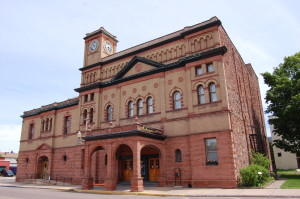
Calumet Theatre – This historic theater was built in 1899 and has hosted well-known singers and theater performers. It still hosts events, and is also open for tours (guided or self-guided) of its (according to the Michigan historical marker on site) “magnificent stage and elegant interior decorations, including an electrified copper chandelier.” Find out more about events and tours at http://www.calumettheatre.com/. Located at 340 Sixth St. in downtown Calumet.
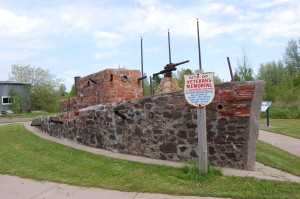
USS Kearsarge Veterans Park – Workers with the WPA (Works Progress Administration) built many of the area’s bridges, public buildings and roads during the Great Depression. They also built the stone ship that sits here on the side of US-41, and while it bears little resemblance to its namesake ship, it is a fitting sculpture for the local veterans memorial. Since the first USS Kearsarge fought in the Civil War, four other ships have bore the same name for the United States Navy. A plaque on site shows what four of those ships looks/looked like, including a battleship that participated in World War I and an aircraft carrier that served in the Korean War and Vietnam War. The names of local residents who have been lost in combat are listed on memorial plaques behind the ship.
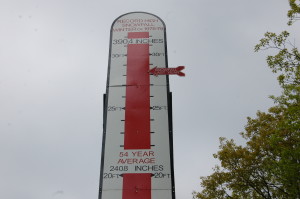
Keweenaw Snow Gauge – When visiting the Keweenaw Peninsula in the spring, summer or fall months it might be hard to picture the are completely covered in snow. A small roadside park north of Mohawk helps show just how much snow can fall during the Upper Peninsula winter here, as a giant snow gauge has been put up to show record snowfall as well as the previous year’s total. If you’re visiting during the heat of June, July or August, just the thought of 390 inches of snow should be enough to help cool you off for a few minutes. The snow gauge stands roughly 30 feet tall, with the highlight being a 390.4 inch total for the 1978-79 season.
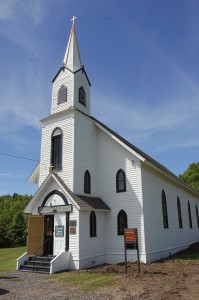
Phoenix – Only a few buildings remain of this former mining town located at the intersection of US-41 and M-26. The Church of the Assumption was moved from Cliff to its current location in 1899, and the Keweenaw County Historical Society has restored it to the way it looked many decades ago. It is open to the public from May to October. The Bammert Blacksmith Shop is right around the corner and has also been restored to its end of the 19th century appearance. Blacksmiths were in high demand during the copper rush, and the shop also features some of the equipment used here (open June through October).
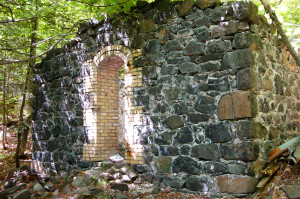
Central Mine – What was once a prosperous copper mine with more than 100 buildings and 100 residents is now just a collection of a handful of standing structures and ruins. Highlights include the Central Mine Methodist Church, Powderhouse Ruins (pictured), and the Miner’s Residence.
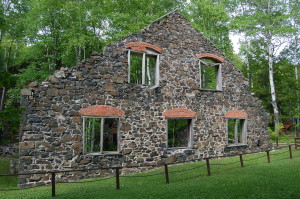
Delaware Mine – Visitors travel 100 feet below the ground for self-guided tours of a copper mine that operated from 1847 to 1887. Above ground you’ll find a gift shop, model trains, walking trails that lead past the remains of the mine’s buildings, and more. Hours, prices and more can be found at http://www.delawarecopperminetours.com/.
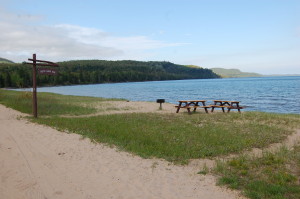
Gay/Lac LaBelle Spur – This side trip “brings travelers along the peninsula’s sandstone eastern shore where remnants of an old stamp mill drape the landscape and mountains rise up from the water.” Popular stops include the “singing sands” at Bete Grise Beach, the Mendota Lighthouse, Montreal Falls, the Bare Bluff hiking trail, Haven Falls and Park, the Bete Grise Preserve, the historic Gay schoolhouse, and the remains of an 1890s stamp mill on the Lake Superior shore.
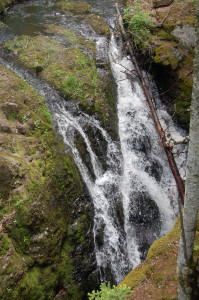
Manganese Falls – This easy to get to 45 foot waterfall is located just south of Copper Harbor and is definitely worth a visit. Manganese Creek drops into a narrow gorge here and there is an overlook that provides views of the top of the falls. From US-41 in downtown Copper Harbor, turn south on Manganese Road and follow it for about a mile to the brown sign for the falls.
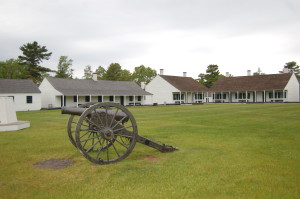
Fort Wilkins Historic State Park – As the copper rush kicked off, there were some worries that there would be conflicts with the native Ojibwa and the miners, so Fort Wilkins was constructed. Things went smooth, however, and the fort was abandoned in 1870. Some structures survived and others were historically constructed so that visitors today can see what life was like at the fort (some summer months even include costumed interpreters). Fort Wilkins also manages the Copper Harbor Lighthouse, and has two campgrounds as part of the state park. For more details visit the Michigan DNR page for Fort Wilkins State Park.
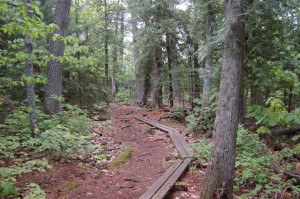
Estivant Pines – Some of the state’s oldest and tallest remaining Eastern White Pine trees are located in a nature preserve near Copper Harbor. Hikers can enjoy two loop trails of around a mile each, and birdwatchers will love trying to spot the 85 different species that have been observed here. From downtown, head south on Second Street for a little over a mile, then bear left onto Clark Mine Rd. Follow Clark Mine Rd. for about a mile, then turn right onto Burma Rd. and proceed about 3/4 of a mile to the parking area.
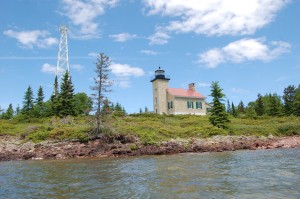
Copper Harbor Lighthouse – The 1866 lighthouse at Copper Harbor helped guide many ships into the harbor during the copper rush. Although its light has been moved to a taller steel skeletal tower, this brick “schoolhouse style” building has been well-preserved. Tour boats used to run out to the lighthouse from the marina but as of 2019 were not running (though the hope is they return soon). The best views of this 42 foot tall lighthouse come from Astor Shipwreck Park (across from Fort Wilkins) or from a kayak.
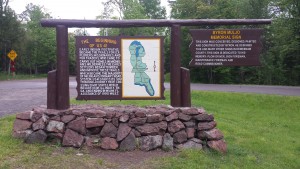
US-41 Sign – “Early Indian footpaths became the trails for explorers, missionaries and fur traders, who came to carve out homes in Michigan’s wilderness. The early settlers began to widen and improve these trails, which became the majority of Michigan’s primary road system, US 41 starts its southbound journey here crossing eight states which include MI., WI., ILL., IND., KY., TN., GA., and ending in Miami, FL., a distance of 1990 miles.” You’ll find this sign east of town, and the dirt road that continues on to the Keweenaw Rocket Range, Horsehoe Harbor, and Keweenaw Point. It’s hard to think of Miami’s warm sandy beaches while here surrounded by Lake Superior and unspoiled natural beauty, but this sign is a reminder that the two places are indeed connected.
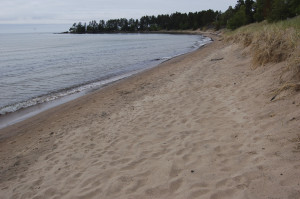
M-26 Lakeshore Drive Spur – This side drive follows the Lake Superior shoreline, passing through the communities of Eagle River and Eagle Harbor. Highlights of this route include Great Sand Bay, Jacobs Falls, Silver River Falls, The Jampot, a Douglass Houghton memorial in Eagle River, Fitzgerald’s Restaurant, the Rathbone School, and three sites that are featured below (Eagle River Falls, Brockway Mountain Drive, and the Eagle Harbor Lighthouse).
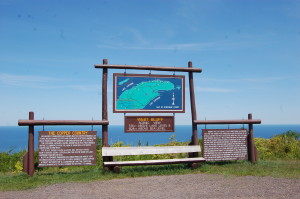
Brockway Mountain Drive – This 10 mile scenic drive takes visitors to the top of a mountain 735 feet above Copper Harbor, where scenic views of Lake Superior and the surrounding area await. Numerous scenic pullouts provide vistas for amazing photographs – this is a can’t-miss stop when fall color reaches its peak. Keep your eyes peeled for eagles and hawks, especially during the spring migration.
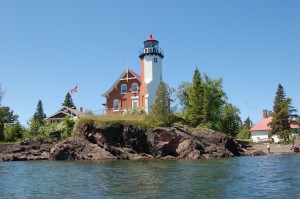
Eagle Harbor Lighthouse – The red and white brick tower of the Eagle Harbor Lighthouse once housed a fourth order Fresnel Lens that warned mariners of the dangerous waters. Today, it is open as a museum where visitors can see what life was like in the late 1800s at this remote lighthouse. Also included in the complex are the Maritime Museum, Commercial Fishing Museum, and the Keweenaw History Museum. A few miles down the road the former Eagle Harbor Life Saving Station has been restored and is a museum site that showcases the efforts of the brave men that left here to save the crews of ships that had wrecked, not knowing whether or not they would return.
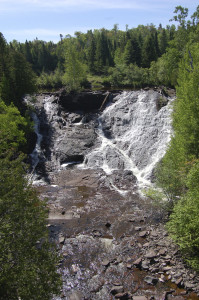
Eagle River Falls – One of the tallest easily accessible falls in the U.P., Eagle River Falls drops 40 feet just before the river empties into Lake Superior. A small roadside park is located here and the falls are viewed from a pedestrian bridge that dates back to 1915 (when it was the bridge carrying what is now M-26 over the river). From the pedestrian bridge you can also view the wooden arch bridge that replaced it; it is 152 feet long and has two arches.
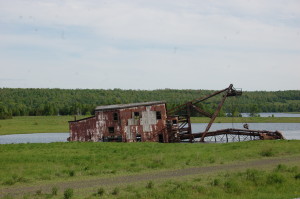
M-26 Lake Linden Spur – There’s plenty to see and do on this side route that runs through several small communities and past many old mining sites. Lake Linden is home to the Houghton County Historical Museum, Hubbell is home to Hungarian Falls, and Tamarack City is the site of an old stamp mill. Driving along M-26 near Mason you’ll see the Quincy Dredge, a reclamation sand dredge sunk in shallow water in Torch Lake. Dollar Bay is home to Horner Flooring, the global leader in the manufacturing of hardwood basketball courts.
Be sure to check out our other scenic byway guides:
20 Things to See and Do on the Top of the Lake Scenic Byway
18 Stops on the Tahquamenon Scenic Byway
US23 Heritage Route – Things to See and So on the Sunrise Side
10 Must-Visit Michigan Locations on the Lake Superior Circle Tour
Whitefish Bay Scenic Drive in the Hiawatha National Forest
Pierce Stocking Scenic Drive at Sleeping Bear Dunes National Lakeshore

